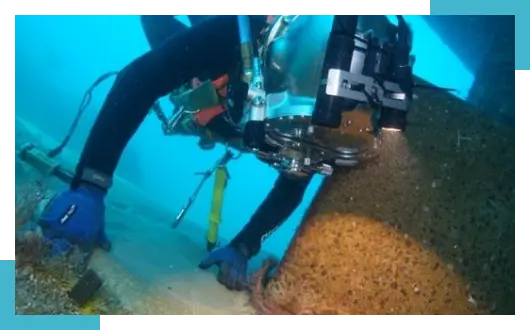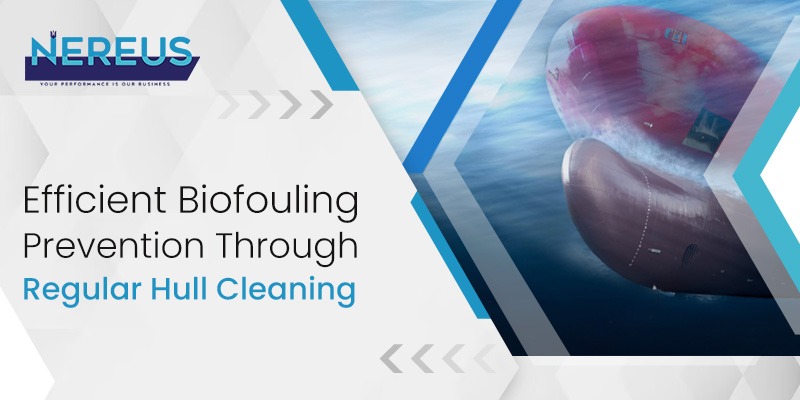One often overlooked aspect that significantly impacts a vessel’s efficiency is biofouling. This blog explores the multifaceted benefits of effective biofouling prevention through regular underwater hull cleaning, the challenges of maintaining a clean hull, and how to tackle these challenges efficiently.
Biofouling, the accumulation of marine organisms on a ship’s hull, is a pervasive challenge. From algae and barnacles to mussels and oysters, these unwanted passengers adhere to the hull, creating drag and hindering the vessel’s hydrodynamic performance. The consequences extend beyond increased fuel consumption, affecting speed, maneuverability, and overall efficiency.
Nereus subsea is the best ship maintenance company in offering high-quality underwater services.
Benefits of Regular Underwater Hull Cleaning
-
Enhanced Fuel Efficiency:
Regular hull cleaning is instrumental in mitigating the drag caused by biofouling. Barnacles and other marine organisms create a rough surface on the hull, increasing resistance as the vessel moves through the water. Cleaning the hull smoothes out the surface, reducing drag and making the ship more hydrodynamic.
With less resistance, the vessel requires less power to maintain a given speed, leading to lower fuel consumption. This translates to significant cost savings for ship operators when it comes to ship cleaning Singapore
-
Optimized Speed and Performance:

A clean hull allows vessels to maintain optimal speeds consistently. Without the hindrance of biofouling, ships can adhere more closely to their designed performance specifications, ensuring smoother and more predictable voyages.
Enhanced maneuverability is a byproduct of reduced drag. Ships with clean hulls respond more promptly to navigation commands, making it easier for captains and crews to navigate through waterways, ports, and challenging conditions.
-
Extended Equipment Lifespan:
Biofouling doesn’t just affect a ship’s performance but it can also accelerate corrosion on the hull. By regular Hull cleaning, operators remove both the marine growth and potential corrosive elements. This underwater maintenance helps protect the ship’s structural integrity, contributing to a longer lifespan for the vessel.
Efficient biofouling prevention is not just about economic gains; it’s also a responsible environmental practice. By reducing fuel consumption, vessels contribute to a smaller carbon footprint, aligning with global sustainability goals.
-
Regulatory Compliance:
Maritime authorities worldwide recognize the environmental and economic impact of biofouling. Many jurisdictions have established regulations mandating the control of biofouling to prevent the spread of invasive species and maintain marine ecosystems. Regular hull cleaning or ship cleaning ensures compliance with these regulations, helping ship operators avoid legal issues and fines.
Contact Nereus Subsea for the best marine services in Singapore.
Challenges in Biofouling Prevention
Biofouling is a long-standing challenge for the marine industry, causing asset depreciation, increased maintenance costs, higher emissions driving climate change, and translocation of non-indigenous marine species.
Biofouling is the accumulation of microorganisms, plants, algae, or small animals on wet surfaces that have a mechanical function, causing structural or other functional deficiencies. Macrofouling, the attachment of larger organisms such as barnacles, soft corals, and seaweed, presents a major threat to vessel marine performance.
Preventative measures to combat biofouling include using an electrolytic system, applying antifouling coatings, and using non-toxic alternatives. In-water cleaning of biofouling from ships, combined with capture of debris and associated biocides, aims to address a significant market need while also directly addressing critical global environmental challenges of reducing air and water pollution and risks of marine non-indigenous species introductions. However, underwater hull cleaning has come under increasing regulatory scrutiny and has fostered the development of new technology.
Ultimately, vessel-specific performance models can provide the feedback shipping companies need to understand the causes and effects of decreasing vessel performance, and the appropriate combination of preventative measures and fouling-release tactics can help combat biofouling and improve vessel efficiency.
While the benefits of regular underwater hull cleaning are evident, challenges persist. Balancing the need for effective cleaning with environmental considerations, exploring eco-friendly cleaning agents, and adopting innovative technologies are crucial steps toward comprehensive biofouling prevention.
Effective Methods For Biofouling Prevention In Underwater Ship Maintenance:
1.In-water cleaning: This method involves removing biofouling from ships to directly address critical global environmental challenges of reducing air and water pollution and risks of marine non-indigenous species introductions.
2.Antifouling coatings: Applying antifouling coatings can help prevent biofouling on ship hulls. However, it is important to monitor the biocide content regulations, which have a direct influence on the efficacy of an applied antifouling coating.
3.Electrolytic system: This system passes a current between two anodes usually made of copper and aluminum. The current produces copper ions that prevent marine organisms from settling on the hull, as well as prevent the surface from corroding, as rough surfaces are more susceptible to biofouling.
4.Ultrasonic system: This method uses high-frequency electrical impulses to prevent marine growth from attaching to the hull
5.Physical barriers: Using physical barriers, such as wraps, nets, or skirts, to cover the hull and prevent fouling organisms from reaching the surface
Ultimately, the appropriate combination of preventative measures and fouling-release tactics can help combat biofouling and improve vessel efficiency. It is also important to understand the factors that influence biofouling occurrence and severity, such as the physical, chemical, and biological characteristics of the water, the design and material of the hull, the operational and maintenance patterns of the ship, and the regulatory and legal requirements of the destination ports.

